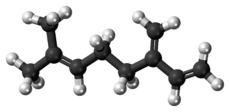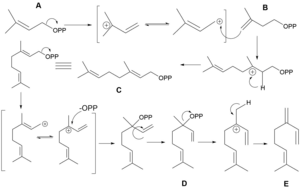Myrcene
Myrcene, or β-myrcene, is an alkene natural hydrocarbon. It is more precisely classified as a monoterpene. Monoterpenes are dimers of isoprenoid precursors, and myrcene is a significant component of the essential oil of several plants, including bay, cannabis, and hops.[3][4] It is produced mainly semi-synthetically from myrcia, from which it gets its name. It is a key intermediate in the production of several fragrances. α-Myrcene is the name for the structural isomer 2-methyl-6-methylene-1,7-octadiene, which has not been found in nature, and is little used. (Based on a 2009 study)[3]
 | |
 | |
| Names | |
|---|---|
| IUPAC name
7-Methyl-3-methylene-octa-1,6-diene | |
| Identifiers | |
3D model (JSmol) |
|
| ChEBI | |
| ChEMBL | |
| ChemSpider | |
| ECHA InfoCard | 100.004.203 |
| KEGG | |
PubChem CID |
|
| UNII | |
CompTox Dashboard (EPA) |
|
| |
| |
| Properties | |
| C10H16 | |
| Molar mass | 136.238 g·mol−1 |
| Density | 0.794 g/cm3 |
| Melting point | < −10 °C (14 °F; 263 K) |
| Boiling point | 166 to 168 °C (331 to 334 °F; 439 to 441 K)[2] |
Except where otherwise noted, data are given for materials in their standard state (at 25 °C [77 °F], 100 kPa). | |
| Infobox references | |
Production

Myrcene is produced by the pyrolysis (400 °C) of β-pinene, which is obtained from turpentine.[3] It is rarely obtained directly from plants.[5]
Terpenes arise naturally from dehydration of terpenol geraniol. Plants biosynthesize myrcene via geranyl pyrophosphate (GPP). The mevalonate pathway gives the precursors dimethylallyl pyrophosphate (Fig. 1a) and isopentenyl pyrophosphate (Fig.1b). These two precursors combine to produce GPP (Fig. 1c), which then isomerizes into linalyl pyrophosphate (Fig. 1d). The rearrangement and release of the pyrophosphate (OPP), and the double bond formation creates the product myrcene (Fig. 1e).[6]
Occurrence
It could in principle be extracted from any number of plants, for example, wild thyme, the leaves of which contain up to 40% by weight of myrcene. Many other plants contain myrcene, sometimes in substantial amounts.[3] Some of these include cannabis,[7] hops, Houttuynia, lemon grass, mango, Myrcia, Verbena, West Indian bay tree, and cardamom.[8]
Of the several terpenes extracted from Humulus lupulus (hops), the largest monoterpenes fraction is β-myrcene. One Swiss study of the chemical composition of the fragrance of Cannabis sativa found β-myrcene to compose between 29.4% and 65.8% of the steam-distilled essential oil for the set of fiber and drug strains tested.[9]
Use in fragrance and flavor industries
Myrcene is an important intermediate used in the perfumery industry. It has a pleasant odor but is rarely used directly.[3] It is also unstable in air, tending to polymerize. Samples are stabilized by the addition of alkylphenols or tocopherol. It is thus more highly valued as an intermediate for the preparation of flavor and fragrance chemicals such as menthol, citral, citronellol, citronellal, geraniol, nerol, and linalool. Myrcene is converted to myrcenol, another fragrance found in lavender, via hydroamination of the 1,3-diene by diethylamine followed by hydrolysis and palladium-catalyzed removal of the amine.[10]
Both myrcene and myrcenol undergo Diels-Alder reactions with several dienophiles such as acrolein to give cyclohexene derivatives that are also useful fragrances, for instance Lyral.[2]
Myrcene also contributes a peppery and balsam aroma in beer.[11][12]
As of October 2018, the U.S. FDA withdrew authorization for the use of myrcene as a synthetic flavoring substance for use in food, without regard to its continuing stance that this substance does not pose a risk to public health under the conditions of its intended use.[13]
See also
- Perfume allergy
References
- Merck Index, 11th Edition, 6243
- Fahlbusch, K.-G.; Hammerschmidt, F.-J.; Panten, J.; Pickenhagen, W.; Schatkowski, D.; Bauer, K.; Garbe, D.; Surburg, H. (2002). "Flavors and Fragrances". Ullmann's Encyclopedia of Industrial Chemistry. Ullmann's Encyclopedia of Industrial Chemistry. Weinheim: Wiley-VCH. doi:10.1002/14356007.a11_141. ISBN 3527306730.
- Behr, A.; Johnen, L. (2009). "Myrcene as a Natural Base Chemical in Sustainable Chemistry: A Critical Review". ChemSusChem. 2 (12): 1072–1095. doi:10.1002/cssc.200900186. PMID 20013989.
- Chyau, C.-C.; Mau, J.-L.; Wu, C.-M. (1996). "Characteristics of the Steam-Distilled Oil and Carbon Dioxide Extract of Zanthoxylum simulans Fruits". Journal of Agricultural and Food Chemistry. 44 (4): 1096–1099. doi:10.1021/jf950577d.
- M. Eggersdorfer (2005). "Terpenes". Ullmann's Encyclopedia of Industrial Chemistry. Weinheim: Wiley-VCH. doi:10.1002/14356007.a26_205.CS1 maint: uses authors parameter (link)
- Dewick, Paul M. (2002). Medicinal Natural Products: A Biosynthetic Approach. New York: John Wiley and Sons, Ltd. p. 174. ISBN 0471496413.
- Booth, Judith K.; Page, Jonathan E.; Bohlmann, Jörg (29 March 2017). Hamberger, Björn (ed.). "Terpene synthases from Cannabis sativa". PLOS One. 12 (3): e0173911. doi:10.1371/journal.pone.0173911. ISSN 1932-6203. PMC 5371325. PMID 28355238.
- Marongiu, B; Piras, A; Porcedda, S (2004). "Comparative analysis of the oil and supercritical CO2 extract of Elettaria cardamomum (L.) Maton". Journal of Agricultural and Food Chemistry. 52 (20): 6278–82. doi:10.1021/jf034819i. PMID 15453700.
- "Essential oil of Cannabis sativa L. strains". druglibrary.net. Retrieved 2017-06-08.
- Kunihiko Takabe, Takao Katagiri, Juntaro Tanaka, Tsutomu Fujita, Shoji Watanabe, And Kyoichi Suga (1989). "Addition of Dialkylamines to Myrcene: N,N-Diethylgeranylamine". Org. Synth. 67: 44. doi:10.15227/orgsyn.067.0044.CS1 maint: uses authors parameter (link)
- Inui, T; Tsuchiya, F; Ishimaru, M; Oka, K; Komura, H (2013). "Different beers with different hops. Relevant compounds for their aroma characteristics". Journal of Agricultural and Food Chemistry. 61 (20): 4758–64. doi:10.1021/jf3053737. PMID 23627300.
- Vázquez Araújo, L.; Rodríguez Solana, R; Cortés Diéguez, S. M.; Domínguez, J. M. (2013). "Use of hydrodistillation and headspace solid-phase microextraction to characterize the volatile composition of different hop cultivars". Journal of the Science of Food and Agriculture. 93 (10): 2568–74. doi:10.1002/jsfa.6078. PMID 23483584.
- 83 FR 50490